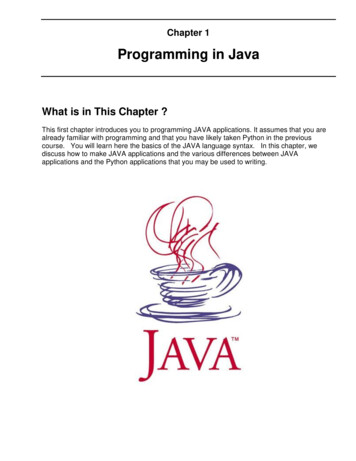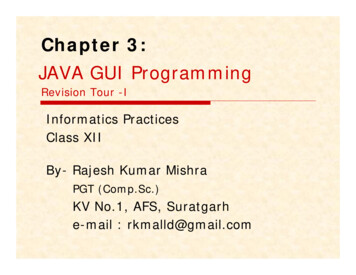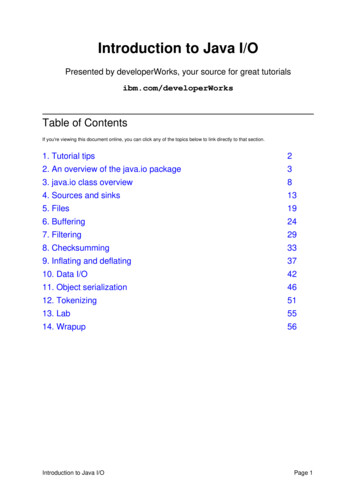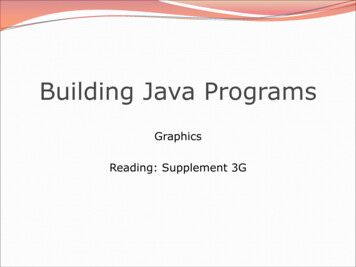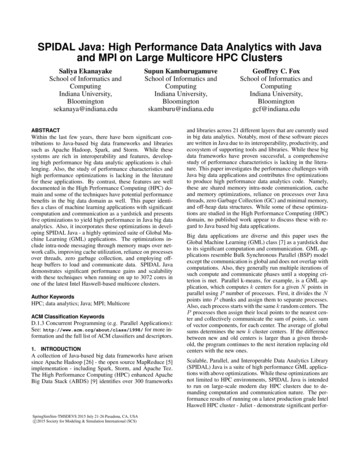
Transcription
SPIDAL Java: High Performance Data Analytics with Javaand MPI on Large Multicore HPC ClustersSaliya EkanayakeSchool of Informatics andComputingIndiana University,Bloomingtonsekanaya@indiana.eduSupun KamburugamuveSchool of Informatics andComputingIndiana Within the last few years, there have been significant contributions to Java-based big data frameworks and librariessuch as Apache Hadoop, Spark, and Storm. While thesesystems are rich in interoperability and features, developing high performance big data analytic applications is challenging. Also, the study of performance characteristics andhigh performance optimizations is lacking in the literaturefor these applications. By contrast, these features are welldocumented in the High Performance Computing (HPC) domain and some of the techniques have potential performancebenefits in the big data domain as well. This paper identifies a class of machine learning applications with significantcomputation and communication as a yardstick and presentsfive optimizations to yield high performance in Java big dataanalytics. Also, it incorporates these optimizations in developing SPIDAL Java - a highly optimized suite of Global Machine Learning (GML) applications. The optimizations include intra-node messaging through memory maps over network calls, improving cache utilization, reliance on processesover threads, zero garbage collection, and employing offheap buffers to load and communicate data. SPIDAL Javademonstrates significant performance gains and scalabilitywith these techniques when running on up to 3072 cores inone of the latest Intel Haswell-based multicore clusters.Author KeywordsHPC; data analytics; Java; MPI; MulticoreACM Classification KeywordsD.1.3 Concurrent Programming (e.g. Parallel Applications):See: http://www.acm.org/about/class/1998/ for more information and the full list of ACM classifiers and descriptors.1.INTRODUCTIONA collection of Java-based big data frameworks have arisensince Apache Hadoop [26] - the open source MapReduce [5]implementation - including Spark, Storm, and Apache Tez.The High Performance Computing (HPC) enhanced ApacheBig Data Stack (ABDS) [9] identifies over 300 frameworksSpringSimSim-TMSDEVS 2015 July 21-26 Pasadena, CA, USAc 2015 Society for Modeling & Simulation International (SCS)Geoffrey C. FoxSchool of Informatics andComputingIndiana University,Bloomingtongcf@indiana.eduand libraries across 21 different layers that are currently usedin big data analytics. Notably, most of these software piecesare written in Java due to its interoperability, productivity, andecosystem of supporting tools and libraries. While these bigdata frameworks have proven successful, a comprehensivestudy of performance characteristics is lacking in the literature. This paper investigates the performance challenges withJava big data applications and contributes five optimizationsto produce high performance data analytics code. Namely,these are shared memory intra-node communication, cacheand memory optimizations, reliance on processes over Javathreads, zero Garbage Collection (GC) and minimal memory,and off-heap data structures. While some of these optimizations are studied in the High Performance Computing (HPC)domain, no published work appear to discuss these with regard to Java based big data applications.Big data applications are diverse and this paper uses theGlobal Machine Learning (GML) class [7] as a yardstick dueto its significant computation and communication. GML applications resemble Bulk Synchronous Parallel (BSP) modelexcept the communication is global and does not overlap withcomputations. Also, they generally run multiple iterations ofsuch compute and communicate phases until a stopping criterion is met. Parallel k-means, for example, is a GML application, which computes k centers for a given N points inparallel using P number of processes. First, it divides the Npoints into P chunks and assign them to separate processes.Also, each process starts with the same k random centers. TheP processes then assign their local points to the nearest center and collectively communicate the sum of points, i.e. sumof vector components, for each center. The average of globalsums determines the new k cluster centers. If the differencebetween new and old centers is larger than a given threshold, the program continues to the next iteration replacing oldcenters with the new ones.Scalable, Parallel, and Interoperable Data Analytics Library(SPIDAL) Java is a suite of high performance GML applications with above optimizations. While these optimizations arenot limited to HPC environments, SPIDAL Java is intendedto run on large-scale modern day HPC clusters due to demanding computation and communication nature. The performance results of running on a latest production grade IntelHaswell HPC cluster - Juliet - demonstrate significant perfor-
mance improvement over traditional implementations on thesame advanced hardware.The rest of the paper is organized as follows. Section 2 introduces SPIDAL Java while Section 3 elaborates its highperformance optimizations. Section 4 presents experimentalresults from running the weighted Deterministic Annealing(DA) Multidimensional Scaling (MDS) algorithm [24] - inSPIDAL against real life health data. It includes speedup andscaling results for a variety of data sizes and compute cores(up to 3072 cores). Section 5 discusses open questions andpossible improvements. Section 6 reviews related work, andfinally, Section 7 presents the conclusions of this work.2.SPIDAL JAVASPIDAL Java provides several multidimensional scaling, andclustering implementations. At present, there is a wellestablished collection of open source big data software suchas those available in the Apache Big Data Stack (ABDS) [9],and it is important to be able to integrate SPIDAL Java applications with such solutions in the long run, hence the choiceof Java to author this suite. Also, with optimizations discussed in Section 3 and the use of Just In Time (JIT) compiler, Java implementations give comparable performance toC/C code.SPIDAL Java currently includes the following GML applications. DA-MDS implements an efficient weighted version ofScaling by MAjorization of a COmplicated Function(SMACOF) [1] that effectively runs in O(N 2 ) comparedto the original O(N 3 ) implementation [24]. It also uses adeterministic annealing optimization technique [23, 14] tofind the global optimum instead of local optima. Given anN xN distance matrix for N high dimensional data items,DA-MDS finds N lower dimensional points (usually 3 forvisualization purposes) such that the sum of error squaredis minimum. The error is defined as the difference betweenmapped and original distances for a given pair of points.DA-MDS also supports arbitrary weights and fixed points- data points that already have the same low dimensionalmapping. DA-PWC is Deterministic Annealing Pairwise Clustering,which also uses the concept of DA, but for clustering [10,23]. Its time complexity is O(N logN ), which is betterthan existing O(N 2 ) implementations [6]. Similar to DAMDS, it accepts an N xN pairwise distance matrix and produces a mapping from point number to cluster number. Itcan also find cluster centers based on the smallest meandistance, i.e. the point with the smallest mean distanceto all other points in a given cluster. If provided with acoordinate mapping for each point, it could also producecenters based on the smallest mean Euclidean distance andEuclidean center. DA-VS is Deterministic Annealing Vector Sponge, whichis a recent addition to SPIDAL. It can perform clusteringin both vector and metric spaces. Algorithmic details andan application of DA-VS to Proteomics data is available at[8]. MDSasChisq is a general MDS implementation based onthe LevenbergMarquardt algorithm [15]. Similar to DAMDS, it supports arbitrary weights and fixed points. Additionally, it supports scaling and rotation of MDS mappings,which is useful when visually comparing 3D MDS outputsfor the same data, but with different distance measures.In addition to GML applications, SPIDAL Java also includesa Web-based interactive 3D data visualization tool - PlotViz[22]. A real life use case on using DA-MDS, DA-PWC, andPlotViz to analyze gene sequences is available at [17].3.HIGH PERFORMANCE OPTIMIZATIONSThis section identifies the performance challenges with bigdata analytic applications and presents the five performanceoptimizations. The details of the optimizations are given withrespect to SPIDAL Java, yet they are applicable to other bigdata analytic implementations as well.3.1Shared Memory Intra-node CommunicationIntra-node communication on large multicore nodes causesa significant performance loss. Shared memory approacheshave been studied as successful alternatives in Message Passing Interface (MPI) oriented researches [3],[27], and [16],however, none are available for Java.SPIDAL Java uses OpenMPI for inter-node communicationas it provides a Java binding of MPI. Its shared memory support, however, is very limited and does not include collectivessuch as variants of allgather, which is used in multidimensional scaling applications.Figure 1. Allgatherv performance with different MPI implementations andvarying intra-node parallelismsFigure 1 plots arithmetic average (hereafter referred to simply as average) running times over 50 iterations of the MPIallgatherv collective against varying intra-node parallelismover 48 nodes in Juliet. Note all MPI implementations wereusing their default settings other than the use of Infinibandtransport. This was a micro-benchmark based on the popularOSU Micro-Benchmarks (OMB) suite [21].The purple and black lines show C implementations compiled against OpenMPI and MVAPICH2 [11], while the greenis the same program in Java compiled against OpenMPI’sJava binding. All tests used a constant 24 million bytes (or3 million double values) across different intra-node parallelism patterns to mimic the communication of DA-MDS,which uses allgatherv heavily, for large data. The experiment shows that the communication cost becomes significant with increasing processes per node and the effect is independent of the choice of MPI implementation and the use
1. All processes, P0 to P5 , write their partial data to themapped memory region offset by their rank and node. Seedownward blue arrows for node 0 and gray arrows for node1 in the figure.2. Communication leaders, C0 and C1 , wait for the peers,{M01 , M02 } and {M10 , M11 } to finish writing. Note leaders wait only for their peers in the same node.Figure 2. Intra-node message passing with Java shared memory mapsFigure 3. Heterogeneous shared memory intra-node messagingof Java binding in OpenMPI. However, an encouraging discovery is that all implementations produce a nearly identicalperformance for the single process per node case. While it iscomputationally efficient to exploit more processes, reducingthe communication to a single process per node was furtherstudied and successfully achieved with Java shared memorymaps as discussed below.Shared memory intra-node communication in Java usesa custom memory maps implementation from OpenHFT’sJavaLang[20] project to perform inter-process communication for processes within a node, thus eliminating any intranode MPI calls. The standard MPI programming would require O(R2 ) of communications in a collective call, whereR is the number of processes. In this optimization, we haveeffectively reduced this to O(N̂ 2 ), where N̂ is the number ofnodes. Note this is an application level optimization ratherthan an improvement to a particular MPI implementation,thus, it will be possible for SPIDAL Java to be ported forfuture MPI Java bindings with minimal changes.Figure 2 shows the general architecture of this optimization where two nodes, each with three processes, are usedas an example. Process ranks go from P0 to P5 and belong to MPI COMM WORLD. One process from each nodeacts as the communication leader - C0 and C1 . These leaders have a separate MPI communicator called COLLECTIVE COMM. Similarly, processes within a node belong toa separate MMAP COMM, for example, M00 to M02 in onecommunicator for node 0 and M10 to M12 in another for node1. Also, all processes within a node map the same memoryregion as an off-heap buffer in Java and compute necessaryoffsets at the beginning of the program. This setup reducesthe communication while carrying out a typical call to an MPIcollective using the following steps.3. Once the partial data is written, the leaders participate inthe MPI collective call with partial data from their peers upward blue arrows for node 0 and gray arrows for node 1.Also, the leaders may perform the collective operation locally on the partial data and use its results for the MPI communication depending on the type of collective required.MPI allgatherv, for example, will not have any local operation to be performed, but something like allreduce maybenefit from doing the reduction locally. Note, the peerswait while their leader performs MPI communication.4. At the end of the MPI communication, the leaders writethe results to the respective memory maps - downward grayarrows for node 0 and blue arrows for node 1. This data isthen immediately available to their peers without requiringfurther communication - upward gray arrows for node 0and blue arrows for node 1.This approach reduces MPI communication to just 2 processes, in contrast to a typical MPI program, where 6 processes would be communicating with each other. The twowait operations mentioned above can be implemented using memory mapped variables or with an MPI barrier onthe MMAP COMM; although the latter will cause intra-nodemessaging, experiments showed it to incur negligible costscompared to actual data communication.While the uniform rank distribution across nodes and a single memory map group per node in Figure 2 is the optimalpattern to reduce communication, SPIDAL supports two heterogeneous settings as well. Figure 3 shows these two modes.Non-uniform rank distribution - Juliet HPC cluster, for example, has two groups of nodes with different core counts (24and 36) per node. SPIDAL Java supports different processcounts per node to utilize all available cores in situations likethis. Also, it automatically detects the heterogeneous configurations and adjusts its shared memory buffers accordingly.Multiple memory groups per node - If more than 1 memory map per node (M ) is specified, SPIDAL Java will select one communication leader per group even for groupswithin the same node. Figure 3 shows 2 memory maps pernode. As a result, O(N̂ 2 ) communication is now changed toO((N̂ M )2 ), so it is highly recommended to use a smaller M ,ideally, M 1.3.2Cache and Memory OptimizationSPIDAL Java employs 3 classic techniques from the linearalgebra domain to improve cache and memory costs - blockedloops, 1D arrays, and loop ordering.
3.4Figure 4. The architecture of utilizing threads for intra-process parallelismBlocked loops - Nested loops that access matrix structuresuse blocking such that the chunks of data will fit in cache andreside there for the duration of its use.1D arrays for 2D data - 2D arrays representing 2D data require 2 indirect memory references to get an element. Thisis significant with increasing data sizes, so SPIDAL Java uses1D arrays to represent 2D data. As such with 1 memory reference and computed indices, it can access 2D data efficiently.This also improves cache utilization as 1D arrays are contiguous in memory.Loop ordering - Data decomposition in SPIDAL Java blocksfull data into rectangular matrices, so to efficiently use cache,it restructures nested loops that access these to go along thelongest dimension within the inner loop. Note, this is necessary only when 2D array representation is necessary.3.3Reliance on Processes over Java ThreadsSPIDAL Java applications support the hybrid approach ofthreads within MPI to create parallel f or regions. Whileit is not complicated to implement parallel loops with Javathread constructs, SPIDAL Java uses Habanero Java library[12] for productivity and performance. It is a Java alternative to OpenMP [4] with support to create parallel regions,loops, etc. Note, threads perform computations only and donot invoke MPI operations. The parent process aggregatesthe results from threads locally as appropriate before usingit in collective communications. Also, the previous sharedmemory messaging adds a second level of result aggregationwithin processes of the same node to further reduce communication. Figure 4 shows the usage of threads in SPIDAL Javawith different levels of result aggregation.Applications decompose data at the process level first andsplit further for threads. This guarantees that threads operateon non-conflicting data arrays; however, Figure 5, 6, and 7show a rapid degrade in performance with increasing numberof threads per process. Internal timings of the code suggestpoor performance occurs in computations with arrays, whichsuggests possible false sharing and suboptimal cache usage.Therefore, while the communication bottleneck with defaultMPI implementations favored the use of threads, with sharedmemory intra-node messaging in SPIDAL Java they offer noadvantage, hence, processes are a better choice than threadsfor these applications.Minimal Memory and Zero Full GCIt is critical to maintain a minimal memory footprint and reduce memory management costs in performance sensitive applications with large memory requirements such as those inSPIDAL Java. The Java Virtual Machine (JVM) automatically manages memory allocations and performs GC to reduce memory growth. It does so by segmenting the program’sheap into regions called generations, and moving objects between these regions depending on their longevity. Every object starts in Young Generation (YG) and gets promoted toOld Generation (OG) if they have lived long enough. Minor garbage collections happen in YG frequently and shortlived objects are removed without GC going through the entire Heap. Also, long-lived objects are moved to the OG.When OG has reached its maximum capacity, a full GC happens, which is an expensive operation depending on the sizeof the heap and can take considerable time. Also, both minor and major collections have to stop all the threads runningin the process while moving the objects. Such GC pauses incur significant delays, especially for GML applications whereslowness in one process affects all others as they have to synchronize on global communications.Initial versions of SPIDAL Java followed the standard Object Oriented Programming (OOP), where objects were created as and when necessary while letting GC take care of theheap. The performance results, however, showed inconsistentbehavior, and detailed GC log analysis revealed processeswere paused most of the time to perform GC. Also, the maxheap required (JVM -Xmx setting) to get reasonable timingquickly surpassed the physical memory in Juliet cluster withincreasing data sizes.The optimization to overcome these memory challenges wasto compute the total memory allocation required for a givendata size and statically allocate required arrays. Also, thecomputation codes reuse these arrays creating no garbage.Another optimization is to use off-heap buffers for communications and other static data, which is discussed in the nextsubsection.While precomputing memory requirements is application dependent, static allocation and array reuse can bring down GCcosts to negligible levels. Benefits of this approach in SPIDAL Java are as follows.Zero GC - Objects are placed in the OG and no transfer ofobjects from YG to OG happens in run-time, which avoidsfull GC.Predictable performance - With GC out of the way, the performance numbers agreed with expected behavior of increasing data and parallelism.Reduction in memory footprint - A DA-MDS run of 200Kpoints running with 1152 way parallelism required about 5GBheap per process or 120 GB per node (24 processes on 1node), which hits the maximum memory per node in our cluster, which is 128GB. The improved version required less than1GB per process for the same parallelism, giving about 5ximprovement on memory footprint.
3.5Off Heap Data StructuresJava off-heap data structures, as the name implies, are allocated outside the GC managed heap and are represented asJava direct buffers. With traditional heap allocated buffers,the JVM has to make extra copies whenever a native operation is performed on it. One reason for this is JVM cannotguarantee that the memory reference to a buffer will stay intact during a native call because it is possible for a GC compaction to happen and move the buffer to a different place inthe heap. Direct buffers, being outside of the heap, overcomethis problem, thus allowing JVM to perform fast native operations without data copying.SPIDAL Java uses off-heap buffers efficiently for the following 3 tasks.Initial data loading - Input data in SPIDAL Java areN xN binary matrices stored in 16-byte (short) big-endianor little-endian format. Java stream APIs such as the typical DataInputStream class are very inefficient in loadingthese matrices. Instead, SPIDAL Java memory maps thesematrices (each process maps only the chunk it operates on) asJava direct buffers.Intra-node messaging - Intra-node process-to-process communications happen through custom off heap memory maps,thus avoiding MPI within a node. While Java memory mapsallow multiple processes to map the same memory region, itdoes not guarantee writes from one process will be visibleto the other immediately. The OpenHFT Java Lang Bytes[20] used here is an efficient off-heap buffer implementation,which guarantees write consistency.MPI communications - While OpenMPI supports both onand off-heap buffers for communication, SPIDAL Java usesstatically allocated direct buffers, which greatly reduce thecost of MPI communication calls.4.TECHNICAL EVALUATIONThis section presents performance results of SPIDAL Java todemonstrate the improvements of previously discussed optimization techniques. These were run on Juliet, which is aproduction grade Intel Haswell HPC cluster with 128 nodestotal, where 96 nodes have 24 cores (2 sockets x 12 coreseach) and 32 nodes have 36 cores (2 sockets x 18 cores each)per node. Each node consists of 128GB of main memory and56Gbps Infiniband interconnect. The total core count of thecluster is 3456, which can be utilized with SPIDAL Java’sheterogeneous support, however, performance testings weredone with a uniform rank distribution of 24x128 - 3072 cores.Figures 5, 6, and 7 show the results for 3 DA-MDS runswith 100K, 200K, and 400K data points. Note, 400K run wasdone with less number of iterations than 100K and 200K tosave time. The green line is for SPIDAL Java with sharedmemory intra-node messaging, zero GC, and cache optimizations. The blue line is for Java and OpenMPI with sharedmemory intra-node messaging and zero GC, but no cache optimizations. The red line represents Java and OpenMPI withno optimizations. The default implementation (red line) couldnot handle 400K points on 48 nodes, hence, it is not shown inFigure 7.Patterns on the X-axis of the graphs show the combinationof threads (T ), processes (P ), and the number of nodes. Thetotal number of cores per node was 24 (12 on each socket),so the Figure 5 through 9 show all possible combinations thatgive 24-way parallelism per node. These tests used processpinning to avoid the Operating System (OS) from movingprocesses within a node, which would diminish data locality benefits of allocated buffers. The number of cores pinnedto a process was 24/P and any threads within a process werealso pinned to a separate core. OpenHFT Thread Affinity [13]library was used to bind Java threads to cores. OpenMPI hasa number of allgather implementations and these were usingthe linear ring implementation of MPI allgatherv as it gavethe best performance. The Bruck [2] algorithm, which is anefficient algorithm for all-to-all communications, performedsimilarly but was slightly slower than the linear ring for thesetests.Ideally, all these patterns should perform the same becausethe data size per experiment is constant, however, resultsshow default Java and OpenMPI based implementation significantly degrades in performance with large process countsper node (red-line). In addition, increasing the number ofthreads, while showing a reduction in the communication cost(Figure 8 and 9), does not improve performance. The Javaand OpenMPI memory mapped implementation (blue-line)surpasses default MPI by a factor of 11x and 7x for 100Kand 200K tests respectively for all process (leftmost 24x48)cases. Cache optimization further improves performance significantly across all patterns especially with large data, as canbe seen from the blue line to the green line (SPIDAL Java).The DA-MDS implementation in SPIDAL Java, for example, has two call sites to MPI allgatherv collective, BCComm and MMComm, written using OpenMPI Java binding[25]. They both communicate an identical number of data elements, except one routine is called more times than the other.Figures 8 and 9 show the average times in log scale for bothof these calls during the 100K and 200K runs.SPIDAL Java achieves a flat communication cost across different patterns with its shared memory-based intra-node messaging in contrast to the drastic variation in default OpenMPI.Also, the improved communication is now predictable andacts as a linear function of total points (roughly 1ms to 2mswhen data size increased from 100K to 200K). This was expected and is due to the number of communicating processesbeing constant and 1 per node.Figure 10 shows speedup for varying core counts for threedata sizes - 100K, 200K, and 400K. These were run as allprocesses because threads did not result in good performance.None of the three data sizes were small enough to have aserial base case, so the graphs use the 48 core as the base,which was run as 1x48 - 1 process per node times 48 nodes.SPIDAL Java computations grow O(N 2 ) while communications grow O(N ), which intuitively suggests larger data sizesshould yield better speedup than smaller ones and the resultsconfirm this behavior.
Figure 5. DA-MDS 100K performance with varying intra-node parallelismFigure 6. DA-MDS 200K performance with varying intra-node parallelismFigure 8. DA-MDS 100K Allgatherv performance with varying intra-nodeFigure 7. DA-MDS 400K performance with varying intra-node parallelism parallelismFigure 9. DA-MDS 200K Allgatherv performance with varying intra-nodeparallelismFigure 11. DA-MDS speedup for 200K with different optimization techniquesFigure 12 shows similar speedup result except run on Juliet’s36 core nodes. The number of cores used within a node isFigure 10. DA-MDS speedup with varying data sizesFigure 12. DA-MDS speedup on 36 core nodesequal to the X-axis’ value divided by 32 - the total 36 core
NAS BMClassCGCGCGLULULULUFortran-O3NAS Java0.971213374.97321526131.11 s1384182722280––ABCWABCSPIDAL Java0.811293538.048215904Table 1. NAS serial benchmark total time in secondsPxNTotalCoresC -O3SPIDAL 0530.3028242189063630.28Table 2. DA-MDS block matrix multiplication time per iteration. 1x1* isthe serial version and mimics a single process in 24x48.node count. It shows a plateau in speedup after 32 processesper node, which is due to hitting the memory bandwidth.Figure 11 shows DA-MDS speedup with different optimization techniques for 200K data. Also, for each optimization,it shows the speedup of all threads vs. all processes within anode. The total cores used range from 48 to 3072, where SPIDAL Java’s 48 core performance was taken as the base case(green line) for all other implementations. The bottom redline is the Java and OpenMPI default implementation withno optimizations. Java shared memory intra-node messaging, zero GC, and cache optimizations were added on top ofit. Results show that Java and OpenMPI with the first twooptimizations (blue line) and all processes within a node surpass all other thread variations. This is further improved withcache optimization (SPIDAL Java - green line) and gives thebest overall performance.Table 1 and 2 show native Fortran and C performance againstSPIDAL Java for a couple of NAS [18] serial benchmarks andblock matrix multiplication in DA-MDS. Table 1 also showsdefault NAS Java performance. Note, the 1x1 serial pattern inTable 2 mimics the matrix sizes for 1 process in 24x48. Theresults suggest Java yields competitive performance using theoptimizations discussed in this paper.5.FUTURE WORKThe current data decomposition in SPIDAL Java assumes aprocess would have enough memory to contain the partialinput matrix and intermediate data it operates on. This setsan upper bound on the theoretical maximum data size itcould handle, which is equal to the physical memory in anode. However, we could improve on this with a multi-stepcomputing approach, where a computation step is split intomultiple computation and communication steps. This willincrease the number of communications, but will still beworthwhile to investigate further.6.RELATED WORKLe Chai’s Ph.D. [3] work identifies the bottleneck in intranode communication with the traditional share-nothing approach of MPI and presents two approaches to exploit sharedmemory-based message passing for MVAPICH2. First is touse a user level shared memory map similar to SPIDAL Java.Second is to get kernel assistance to directly copy messagesfrom one process’s memory to the other. It also discusses howcache optimizations help in communication and how to address Non Uniform Memory Access (NUMA) environments.Hybrid MPI (HMPI) [27] presents a similar idea to the zerointra-node messaging in SPIDAL Java. It implements a custom memory allocation layer that enable
Java big data applications and contributes five optimizations to produce high performance data analytics code. Namely, these are shared memory intra-node communication, cache and memory optimizations, reliance on processes over Java threads, zero Garbage Collection (GC) and minimal memory, and off-heap data structures. While some of these .


